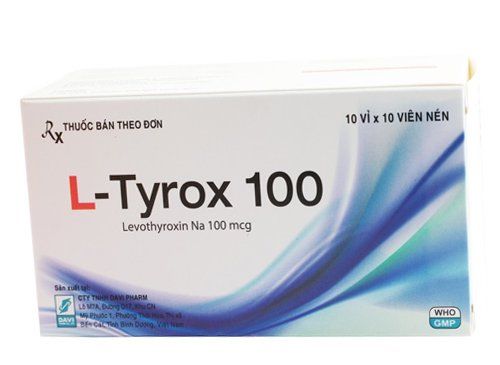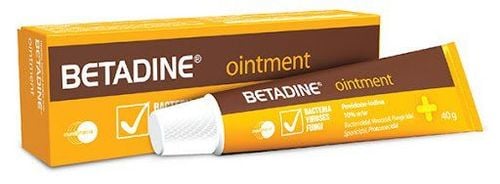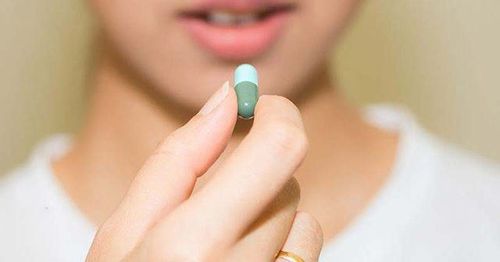This is an automatically translated article.
Flamipio is a medication commonly used to treat hyperthyroidism. This would include Graves' disease, toxic multinodular goiter, and thyroid toxicity crisis. To better understand what is Flamipio? What disease does Flamipio treat? What are the harmful interactions of Flamipio? What is the correct way to drink? What points should you pay attention to when using? The following article will help you better understand the drug Flamipio.1. What is Thiamazol 5mg?
Thiamazol and carbimazol are thioimidazole derivatives antithyroid drugs.In the body, carbimazol will be rapidly and completely metabolized to thiamazol.
1.1. Drug form and strength
Tablets: 5 mg, 10 mg and 20 mg.1.2. Element
Thiamazol 5mg1.3. Pharmacodynamic
Thiamazol is a synthetic antithyroid drug, thioimidazole derivative that inhibits thyroid hormone synthesis by altering the reaction of oxidized iodide to the tyrosine moiety of the thyroglobulin molecule and the coupling reaction. iodotyrosine to iodothyronine. In addition, thiamazol also inhibits the thyroid peroxidase enzyme, which prevents the oxidation of iodide and iodine tyrosine to the active form. Thiamazol does not inhibit the action of thyroid hormone that is already formed in the thyroid gland or is present in the circulation, does not inhibit the release of thyroid hormone, nor does it affect the effectiveness of externally administered thyroid hormone. Therefore, thiamazol is not effective in the treatment of thyrotoxicosis caused by overdosage of thyroid hormone.If thiamazol is used in too high a dose and for a long time, it can cause hypothyroidism. Low levels of thyroid hormone cause the pituitary gland to increase secretion of thyroid-stimulating hormone (TSH). TSH re-stimulates thyroid growth, which can cause goiter. To avoid this, when thyroid function has returned to normal, either a moderately low dose, to only suppress thyroid hormone production to a certain extent, or a combination of synthetic thyroid hormone. such as levothyroxine, so that the pituitary gland does not increase TSH secretion. Unlike antithyroid drugs of thiouracil derivatives (benzylthiouracil, propylthiouracil, methylthiouracil), thiamazol does not inhibit the peripheral deiodination of thyroxine to triiodothyronin (the effect of triiodothyronine is much stronger than that of thyroxine). Therefore, in the treatment of thyrotoxicosis, propylthiouracil is often preferred.
By weight, thiamazol is 10 times stronger than benzyl thiouracil and propylthiouracil (10 times). In one study, blood levels of thyroxine and triiodothyronin decreased significantly after 5 days of thiamazol 40 mg daily. The maximum effect is achieved after 4-7 weeks.
1.4. Pharmacokinetics
Thiamazol is rapidly absorbed from the gastrointestinal tract after oral administration. If taken with food, absorption is not anticipated. Bioavailability is 93%. Placed rectally, the drug is absorbed as when taken orally. Peak plasma concentrations are reached within 1 hour after oral administration. Administering 60 mg of thiamazol to healthy subjects, peak concentrations were achieved at 1.18 micrograms/ml.Thiamazol is highly concentrated on the thyroid gland. The volume of distribution is 0.6 liters/kg. The drug is not significantly bound to plasma proteins. Thiamazol crosses the placental barrier and is secreted into breast milk at concentrations close to those in maternal plasma. The drug is metabolized mainly in the liver. No active metabolites have been detected.
Elimination half-life of thiamazol is about 3-6 hours. In hepatic impairment, the elimination half-life may be prolonged. The drug is excreted in the urine as metabolites, with less than 10% as unchanged drug.
2. What are the uses of Thiamazol?
The main active ingredient of the drug is thiamazol with therapeutic effects:Symptomatic treatment of thyrotoxicosis. Thyrozol is used as preoperative treatment for thyroid disease due to hyperthyroidism to prevent a possible bout of thyrotoxicosis. In addition, it is also used as adjuvant therapy before and during radioactive iodine treatment. Not only that, Thyrozol is also indicated for the treatment of thyrotoxicosis before using iodized salt.
3. Unwanted side effects of Thiamazol drugs
Blood: Usually leukopenia is usually mild. But about 10% of patients with hyperthyroidism do not receive treatment, and the white blood cell count often falls below 4000/mm3. Skin: Itching, skin rash, hair loss Body as a whole: Headache and fever Chills, sore throat, cough, sore mouth and hoarse voice. It is more common in patients who are elderly or taking doses of 40 mg/day or more. Vasculitis, tachycardia. Joint pain, arthritis, muscle pain. Peripheral neuritis. Loss of taste, nausea, vomiting.4. Harmful interactions of drugs Thiamazol 5mg
Aminophylline, oxtripylin or theophylline. Amiodarone, iodine glycerol, iodine or potassium iodide. Coumarin or indandion-derivative anticoagulants. Beta-blockers, cardiac glycosides: Hyperthyroidism increases the metabolism and elimination of beta-blockers or cardiac glycosides, the dose of these drugs should be reduced when the patient's thyroid returns to normal due to thiamazol. Radioiodinated salts: Thiamazol reduces the absorption of iodine into the thyroid gland. If thiamazol is stopped suddenly, after about 5 days, iodine absorption will increase again.5. How to use Thiamazol effectively?
5.1. How to use
Medicines do not cure the cause of hyperthyroidism. Depending on the severity of hyperthyroidism, choose the appropriate dose. For adults, the daily oral dose is 15-60mg, divided equally into 3 times, each time 8 hours apart. The drug can be taken as a single dose or divided into 2 doses, the effectiveness may be poor, but in some people, side effects are less and more tolerable for the patient.Thiamazol must be discontinued 2-4 days before radioiodine therapy to avoid interference with this therapy. If necessary, thiamazol can be resumed 3-7 days later, until radioiodine therapy takes effect.
The duration of medication to achieve remission must be long, usually ranging from 6 months to 1-2 years.
Swallow the tablet whole with a sufficient amount of water.
During treatment of hyperthyroidism with a high starting dose, the daily dose should be divided and taken at regular intervals throughout the day.
Maintenance dose can be taken once in the morning, during or after breakfast.
5.2. Dosage
Dosage for adults:Depending on the severity of the disease and the amount of iodine used, usually start treatment with a daily dose of 10-40mg. In many cases, suppression of thyroid hormone production can usually be achieved with an initial dose of 20 to 30 mg of thiamazole. In milder cases, an adequate inhibitory dose may not be necessary, so a lower starting dose may be considered. In cases of severe hyperthyroidism, an initial dose of 40 mg thiamazole may be required. The starting dose is adjusted according to the patient's metabolic condition, as indicated by the progression of thyroid hormone status. For maintenance therapy, one of the following recommendations should be used: Daily maintenance dose of 5 to 20 mg thiamazole in combination with levothyroxine, to avoid hypothyroidism. Single therapy with a daily dose of 2.5 to 10 mg thiamazole. Iodine-induced hyperthyroidism may require higher doses. Dosage for children:
The average starting dose for children is 0.5mg thiamazole/kg body weight per day. After thyroid function returns to normal, the dose is gradually reduced to a lower maintenance dose, depending on the patient's metabolic condition. Additional treatment with levothyroxine may be used to avoid hypothyroidism. Conservative treatment of hyperthyroidism:
The goal of treatment is to achieve euthyroid metabolism and long-term recovery after a certain course of treatment. Depending on the choice of patient to be treated, the one-year recovery achieved in 50% of cases is the highest. Reported recovery rates vary widely for no apparent reason. The type of hyperthyroidism (immune or non-immune), duration of treatment, dose, as well as the amount of iodine used are definitely influencing factors. In conservative treatment of hyperthyroidism, the duration of treatment usually lasts from 6 months to 2 years (mean is 1 year). According to statistics, the possibility of recovery will increase with the time of treatment. In cases where recovery cannot be achieved and definite treatments are not applied or refused, thiamazole can be used as long-term antithyroid therapy for a low dose of without the addition or combination of levothyroxine. Patients with large goiters and tracheal obstruction should only be treated with short-term thiamazole because long-term use can lead to goiter growth. Particular monitoring of the entire course of treatment (TSH levels, tracheal lumen) may be necessary. It is best to be treated in combination with the addition of levothyroxine. Treatment before surgery:
Temporary treatment (for 3 to 4 weeks or longer, in individual cases) can achieve euthyroid metabolic conditions, thereby reducing the risk of surgery. Surgery should be performed as soon as the patient achieves euthyroid levels. Otherwise, levothyroxine should be used. Treatment may be finished the day before surgery. The risk of increased brittleness and bleeding of thyroid tissue due to thiamazole can be compensated by administration of high doses of iodine 10 days before surgery (Plummer iodine therapy). Treatment before radioiodine therapy:
Achieving parathyroid metabolism prior to radioiodine therapy is particularly important in severe cases of hyperthyroidism, because a bout of post-treatment thyrotoxicosis has occurred. occurred in individual cases after radioactive iodine treatment without prior treatment. Note: Thionamide derivatives may decrease the radiosensitivity of thyroid tissue. In the programmed radioiodine treatment of autologous thyroid nodules, activation of the paranodular thyroid tissue by pretreatment must be prevented. Interval therapy after radioactive iodine therapy:
The duration and dose of treatment must be individually adjusted depending on the clinical condition and anticipated time until radioiodine therapy begins. effect (about 4 to 6 months). Prophylactic treatment in patients at risk of developing hyperthyroidism due to the use of iodine-containing substances for diagnostic purposes:
Generally, a daily dose of 10 to 20 mg thiamazole and/or 1 g perchlorate for approximately 10 days, (eg, for renally excreted contrast media). The duration of treatment depends on how long the iodine-containing substance remains in the body. Special cases:
In patients with hepatic impairment, plasma clearance of thiamazole is reduced. Therefore, the dose should be kept as low as possible and the patient should be carefully monitored. Since there are insufficient data regarding the pharmacokinetics of thiamazole in patients with renal impairment, careful individual dose adjustment and close monitoring are recommended. Dosage should be kept as low as possible. Although no accumulation occurs in the elderly, careful individual dosing is required and close monitoring is recommended.
5.3. In case of emergency or overdose
In the event of an emergency or overdose, immediately call 911 or go to the nearest local health station.5.4. In case you miss a dose?
If you forget to take a dose, take it as soon as possible. However, if it is almost time for your next dose, skip the missed dose and take your next dose at the scheduled time. Do not take twice the prescribed dose.6. Precautions/Warnings when using Thiamazol
6.1. What should you know before taking thiamazole?
When deciding to use a drug, it is important to weigh the benefits and risks that it brings. You need to consult your doctor. For this medicine the following should be considered:Allergies: Tell your doctor if you have ever had any unusual or allergic reaction to this or any other medicine . Also tell your health care provider if you have any allergies such as allergies to foods, dyes, preservatives, or animals. For over-the-counter products, also read the ingredient label or package carefully. Children: Studies have not yet demonstrated a problem specific to children that would limit the benefits of thiamazole. Elderly: There is no information on the relationship of age to the effects of methimazole in the elderly.
6.2. Things to keep in mind if you are pregnant or breastfeeding
There are not enough studies to determine the risks of taking this medicine during pregnancy or breast-feeding. Before taking medication, always consult with your doctor to weigh the benefits and risks. This drug belongs to the category D drugs for pregnancy, according to the U.S. Food and Drug Administration (FDA).7. How to store Thiamazol?
Store the medicine in a cool, dry place, avoid direct sunlight and avoid moisture. The suitable temperature for drug storage is < 25°C. Keep the medicine out of the reach of children and young children. Do not use expired medicine. Note that unused medicine should not be thrown into household waste because this may cause environmental pollution. Therefore, it should be treated before being released into the environment. Reference source: youmed.vnPlease dial HOTLINE for more information or register for an appointment HERE. Download MyVinmec app to make appointments faster and to manage your bookings easily.













